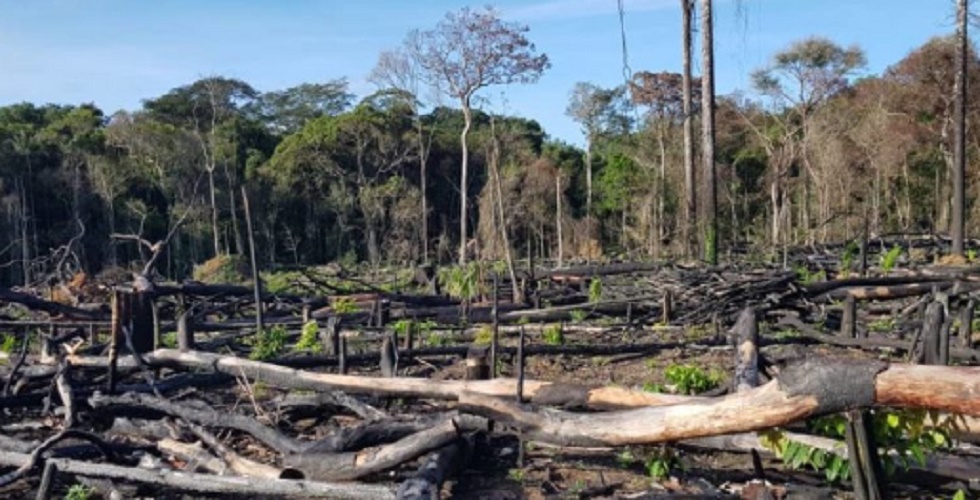What is deforestation?
We explain what deforestation is, its causes, consequences and types. In addition, how to avoid it and its relationship with desertification.
-
What is deforestation?
Deforestation is the destruction of the forest area . It is usually due to human action, by cutting or burning trees, with the aim of winning industrial inputs (the industrial timber and paper, among others) or arable land for agricultural work.
It is possible, however, that forests suffer similar damage due to natural accidents , such as forest fires during drought or volcanic activity.
However, deforestation is one of the most serious threats that currently hangs over the forest masses of the planet . It puts the home of millions of species in check and has a tremendous impact on soil deterioration and carbon sequestration .
Consequently, numerous initiatives worldwide try to sensitize the population on the urgency to tighten laws to protect large forest reserves and investing resources in recovering forests globally.
-
Types of deforestation
Deforestation is a unique phenomenon, which can be classified according to its causes in:
- Natural deforestation : It is due to the effects of natural accidents and events of the earth’s dynamics.
- Human deforestation : It is the direct or indirect fruit of human activities, and they are therefore our responsibility.
-
Causes of deforestation
The main causes of deforestation have to do with:
- Expansion of the urban spot . The cities grow, as the population increases, and require new space to build houses and roadworks. The forests are the first to pay the price.
- Indiscriminate logging for agricultural purposes . The increase in the world population implies the need to produce more and more food , so that more and more cultivable areas are required. To do this, it is usually clearing entire sections of forests and turning them into farms or grazing fields.
- Wood and paper operations on a large scale . The wood, pulp and paper industries, among others derived from trees, feed on consuming huge annual sections of the main forests. Although sometimes these companies also invest in reforestation programs, the pace of logging is always much higher than the pace of planting new trees.
- Forest fires, volcanoes and other natural phenomena . Although this is very feasible and sometimes recurring (as in the case of spontaneous fires during times of great drought), these are very minor events compared to the causes linked to humanity.
- Poor forest laws and neglectful states . Ultimately, the responsibility to protect these natural treasures rests with the states in whose territories forests are given, but many of them lack the incentive to protect them, especially when this involves the loss of money.
-
Consequences of deforestation

The consequences of large-scale deforestation are neither few nor easy to remedy. Among the main ones are:
- Loss of biodiversity . The jungles and forests are some of the most fertile ecosystems on the planet, housing thousands or millions of life forms of all kinds (70% of continental life), a high percentage of which has not even been discovered by mankind. All this is put at risk if we destroy their habitat .
- Increase of carbon in the atmosphere . The forests fulfill a thermoregulatory function of the planet, since they absorb large amounts of CO 2 and replace it by photosynthesis with respirable oxygen, fixing the remaining carbon in their bodies. Without them, carbon dioxide levels in the atmosphere will increase, oxygen levels will decrease. In addition, the global temperature will increase , as CO 2 is the main greenhouse gas .
- Destruction of soils . Solar radiation, wind and rain, all erosive factors, are greatly attenuated by the presence of forests, which act as a defense of the soil. Without them, the elements directly affect the ground, causing relief changes and uncontrolled erosions .
- Impoverishment of the air . Forests also release significant amounts of water vapor into the atmosphere, which helps keep the soil moist and contributes to the hydrological cycle . The decrease in this contribution produces drier airs.
-
Deforestation and desertification
One of the most terrible phenomena associated with large-scale deforestation is desertification, that is, the emergence of new deserts or expansion of existing deserts.
This phenomenon is due to the impoverishment of the soils, the desiccation of the atmosphere and the greater incidence of solar radiation . In a short time, it is capable of converting a fertile ground into an arid one, making it difficult even the planting work for which, often, the forest that inhabited it was cut down by human hands.
-
How to avoid deforestation
The fight against deforestation has no simple solution. Ideally, it should be the product of the sustained effort of States and Non-Governmental Organizations (such as Community Forestry International, WWF, Greenpeace and others).
It should also be the responsibility of the logging industries themselves in a responsible manner , that is, at a rate that allows reforestation and that meets the strictly necessary needs of the demand.
On the other hand, there is the idea of alternating felled forests , allowing enough time for plant life to recover minimally. Pulp recycling activities can also be promoted through the collection of waste paper and wood.
At the same time, stricter legislation that encourages all of the above would have to be a priority in most countries.
-
Reforestation
Reforestation is the effort to plant new forests or grow existing ones . It can be done by protecting them, or by spreading seeds, as well as the individual planting of citizens .
Many of these initiatives have paid off in the early years of the 21st century, and the amount of forest is considered to have grown in 22 of the 50 countries with the largest forest reserves on the planet. Thanks to reforestation, it is estimated that between 1990 and 2015 the world’s forest area increased by 7% .
-
Deforestation in Mexico
In the Mexican territory there are 138 million hectares of forest vegetation, especially lush in the southern regions, where they meet the Central American jungle. Of all this , 3.2 million hectares have been lost between 2001 and 2017, 6% of the forest territory , which is a bad news for the ecology of the region.
FAO studies estimate that 34% of the fauna of these forests is endemic , that is, that it cannot make life anywhere else on the planet. This means that 12% of it will disappear completely in the coming years if nothing is done to prevent it.
This is a problem that Mexico shares with other Latin American countries , such as Brazil, Peru, Bolivia and Colombia.
-
Deforestation in the Amazon

The Amazon Rainforest is one of the largest forest areas in the world , in which one in ten species known to mankind inhabit : which constitutes it as the largest reserve of planetary biodiversity. In addition, it is one of the planetary “lungs”, fixing huge amounts of carbon that would otherwise end up in the atmosphere.
However, Amazonian nations (Brazil, Bolivia, Peru, Colombia and Venezuela) exploit this resource in different ways, to provide land for agriculture , livestock and mining, or resources to wood industries.
The issue of Amazonian deforestation, whose effects on the local climate are already felt, came into view when 169,800 hectares of forest burned during the month of August 2019 , mainly in the territories of Brazil and Bolivia.
This unleashed international concern and outrage. However, exploitation activities in the region take years , if not decades, being denounced by environmental activists and by spokesmen of the ancestral communities that still live a long way from civilization, in the bowels of the Amazon.





